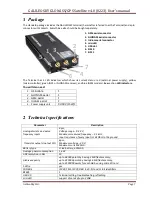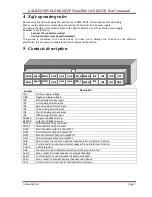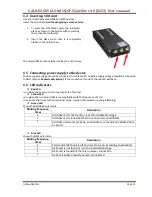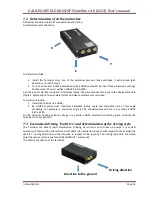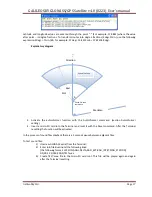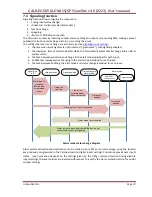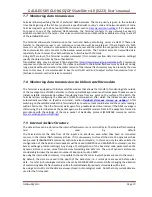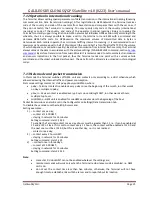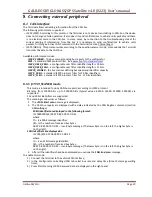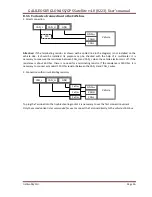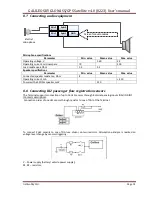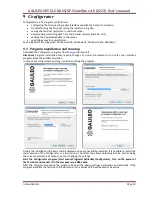
GALILEOSKY GLONASS/GPS Satellite v4.0 (0223) User’s manual
GalileoSky Ltd.
Page 19
7.7
Monitoring data transmission
Terminal allows specifying the list of preferred GSM-networks. The main priority is given to the networks
from the beginning of the list. Every network is specified with country’s code and network operator’s code.
Terminal supports up to 30 networks (OPS0 command, section
Data transmission settings
). If it’s impossible
to connect to one of the preferred GSM-networks, the Terminal connects to any network but doesn’t
establish connection to the server, thus voice communication and SMS will be available according to a tariff
of the installed SIM-card.
The Terminal allows data transmission to the main and backup monitoring server via GSM. If there only
transfer to the main server is set, continuous connection will be maintained. If there transfer to both
servers is set, the Terminal is connected to the main server and then after the set period of time it breaks
the communication and connects to the backup server and etc. The Terminal accounts transmitted data
separately for each server, thus both will receive full archive with the track.
Using EGTS protocol, the Terminal number parameter (ID command, section Data transmission settings)
specify the object number by the authentication.
Transmitted data may be coded; XTEA3 algorithm (
http://tomstdenis.tripod.com/xtea.pdf
). Commands,
responses and photos are not coded. The data are archived in the internal flash-memory by default. During
long periods without connection the oldest records of the internal flash-memory may be erased by the new
ones. In this case, it is recommended to insert a micro-SD card and to adjust archive transmission from it
(Archive command, section Service command).
7.8
Monitoring data transmission via Iridium satellite modem
The Terminal is equipped with Iridium satellite modem that allows the transfer of monitoring data outside
of the coverage zone of GSM-networks. In this case, GalileoSky protocol and Iridium packet heads are used.
Iridium satellite communication allows transferring data from any point on the surface of the Earth. The
Terminal allows configuring the absence of GSM communication after which the Iridium modem will be
automatically switched on (Sputnic command, section
Ошибка! Источник ссылки не найден.
). After
switching on the satellite modem the Terminal will try to send current coordinates and the sensors readings
within 10 minutes. Then the Terminal waits again for a predetermined time interval, if the GSM coverage is
still missing, the terminal sends the packet again via the satellite modem. Data in the packet are formed in
accordance with the settings of the main packet of GalileoSky protocol (MAINPACK command, section
Server exchange protocol settings
).
7.9
Internal Archive Structure
The data archive can be stored on the internal flash-memory or a
micro-SD card. The internal flash memory
card
is
used
by
default.
The Terminal stores the data from all the inputs and interfaces, even when they have no connected
sensors, in the internal flash-memory archive. If it is unnecessary to store all the data, the dynamic archive
can be used (FLASHARCHIVE command, section Service commands). In this case, only the data selected in
configuration of the head and main packets will be saved (HEADPACK and MAINPACK commands, section
Server exchange protocol settings). Any change of configuration of the head and main packets when the
dynamic archive is on can cause flash-memory formatting and data loss. The use of dynamic archive can
considerably increase the maximum number of kept points up to 58000.
By using the internal flash memory it is possible to choose the order in which points are sent to the server.
By default, the data are saved in the depth of the data store, i.e. current data are saved before older
data. Transfer in chronological order can be set by FLASHARCHIVE command .After changing the direction
of memorizing data the flash-memory will be formatted and all previously stored data will be lost.
By using a micro-SD card the data are always stored in chronological order. Note that only current data are
used for the first packet.



